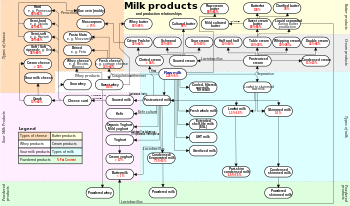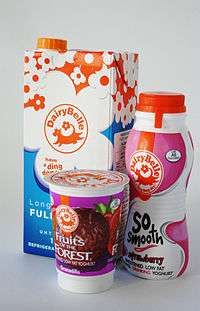Dairy product


Dairy products or milk products are a type of food produced from or containing the milk of mammals, primarily cattle, water buffaloes, goats, sheep, and camels.[1][2][3] Dairy products include food items like yogurt, cheese, and butter.[4][5] A facility that produces dairy products is a dairy or dairy factory.[6] Dairy products are often consumed worldwide, except for most of East and Southeast Asia and parts of central Africa.[7]
Types of dairy products

- Milk after optional homogenization, pasteurization, in several grades after standardization of the fat level, and possible addition of the bacteria Streptococcus lactis and Leuconostoc citrovorum
- Crème fraîche, slightly fermented cream
- Clotted cream, thick, spoonable cream made by heating milk
- Single cream, double cream and whipping cream
- Smetana, Central and Eastern European variety of sour cream
- Cultured milk resembling buttermilk, but uses different yeast and bacterial cultures
- Kefir, fermented milk drink from the Northern Caucasus
- Kumis/Airag, slightly fermented mares' milk popular in Central Asia
- Powdered milk (or milk powder), produced by removing the water from (usually skim) milk
- Whole milk products
- Buttermilk products
- Skim milk
- Whey products
- High milk-fat and nutritional products (for infant formulas)
- Cultured and confectionery products
- Condensed milk, milk which has been concentrated by evaporation, with sugar added for reduced process time and longer life in an opened can
- Khoa, milk which has been completely concentrated by evaporation, used in Indian cuisine including gulab jamun, peda, etc.)
- Evaporated milk, (less concentrated than condensed) milk without added sugar
- Ricotta, acidified whey, reduced in volume
- Infant formula, dried milk powder with specific additives for feeding human infants
- Baked milk, a variety of boiled milk that has been particularly popular in Russia
- Crème fraîche, slightly fermented cream
- Butter, mostly milk fat, produced by churning cream
- Buttermilk, the liquid left over after producing butter from cream, often dried as livestock feed
- Ghee, clarified butter, by gentle heating of butter and removal of the solid matter
- Smen, a fermented, clarified butter used in Moroccan cooking
- Anhydrous milkfat (clarified butter)
- Cheese, produced by coagulating milk, separating from whey and letting it ripen, generally with bacteria and sometimes also with certain molds
- Curds, the soft, curdled part of milk (or skim milk) used to make cheese
- Paneer
- Whey, the liquid drained from curds and used for further processing or as a livestock feed
- Cottage cheese
- Quark
- Cream cheese, produced by the addition of cream to milk and then curdled to form a rich curd or cheese
- Fromage frais
- Casein are
- Caseinates, sodium or calcium salts of casein
- Milk protein concentrates and isolates
- Whey protein concentrates and isolates, reduced lactose whey
- Hydrolysates, milk treated with proteolytic enzymes to alter functionality
- Mineral concentrates, byproduct of demineralizing whey
- Yogurt, milk fermented by Streptococcus salivarius ssp. thermophilus and Lactobacillus delbrueckii ssp. bulgaricus sometimes with additional bacteria, such as Lactobacillus acidophilus
- Clabber, milk naturally fermented to a yogurt-like state
- Gelato, slowly frozen milk and water, lesser fat than ice cream
- Ice cream, slowly frozen cream, milk, flavors and emulsifying additives (dairy ice cream)
- Ice milk, low-fat version of ice cream
- Frozen custard
- Frozen yogurt, yogurt with emulsifiers
- Other
Health
Dairy products can cause health issues for individuals who have lactose intolerance or a milk allergy.[8][9]
Additionally dairy products including cheese, ice cream, milk, butter, and yogurt can contribute significant amounts of cholesterol and saturated fat to the diet. Diets high in fat and especially in saturated fat can increase the risk of heart disease and can cause other serious health problems. [10] However, it has been shown that there is no connection between dairy consumption (excluding butter) and cardiovascular disease, even though dairy tends to be higher in saturated fats.[11]
There is no excess cardiovascular risk with dietary calcium intake but calcium supplements are associated with a higher risk of coronary artery calcification. Anderson JJ, Kruszka B, Delaney JA, et al. Calcium intake from diet and supplements and the risk of coronary artery calcification and its progression among older adults: 10-year follow-up of the Multi-Ethnic Study of Atherosclerosis (MESA). J Am Heart Assoc 20161; DOI:10.1161/jaha.116.003815
Consumption patterns worldwide
Rates of dairy consumption vary widely worldwide. High-consumption countries consume over 150 kg per capita per year: Argentina, Armenia, Australia, Costa Rica, Europe, Israel, Kyrgyzstan, North America and Pakistan. Medium-consumption countries consume 30 to 150 kg per capita per year: India, Iran, Japan, Kenya, Mexico, Mongolia, New Zealand, North and Southern Africa, most of the Middle East, and most of Latin America and the Caribbean. Low-consumption countries consume under 30 kg per capita per year: Senegal, most of Central Africa, and most of East and Southeast Asia.[7]
Avoidance
Some groups avoid dairy products for non-health related reasons:
- Religious - Some religions restrict or do not allow for the consumption of dairy products. For example, some scholars of Jainism advocate not consuming any dairy products because dairy is perceived to involve violence against cows. Strict Judaism requires that meat and dairy products not be served at the same meal, served or cooked in the same utensils, or stored together, as prescribed in Deuteronomy 14:21.
- Ethical - Veganism is the avoidance of all animal products, including dairy products, most often due to the ethics regarding how dairy products are produced. The ethical reasons for avoiding dairy include how dairy is produced, how the animals are handled, and the environmental effect of dairy production.
See also
- Fermented milk products
- List of dairy product companies in the United States
- List of foods
- Plant milk
References
- ↑ "dairy product - definition of dairy product in English | Oxford Dictionaries". Oxford Dictionaries | English. Retrieved 2016-11-11.
- ↑ writer, Julie R. Thomson Food (2014-10-14). "PSA: Eggs Are NOT Dairy". The Huffington Post. Retrieved 2016-11-11.
- ↑ "Dairy production and products: Dairy animals". www.fao.org. Retrieved 2016-10-29.
- ↑ "Dairy | Clemson University, South Carolina". www.clemson.edu. Retrieved 2016-11-11.
- ↑ "Is Butter a Dairy Product, and Does it Contain Lactose?". Authority Nutrition. 2016-07-01. Retrieved 2016-11-11.
- ↑ "Definition of DAIRY". www.merriam-webster.com. Retrieved 2016-10-29.
- 1 2 Food and Agriculture Organization of the United Nations, "Dairy production and products: Milk and milk products"
- ↑ "Lactose intolerance". Genetics Home Reference. 2016-02-08. Retrieved 2016-02-12.
- ↑ "Milk Allergy - Food Allergy Research & Education". www.foodallergy.org. Retrieved 2016-02-12.
- ↑ "Saturated Fat". Retrieved 16 June 2016.
- ↑ Lovegrove, JA (February 24, 2016). "Plenary Lecture 2: Milk and dairy produce and CVD: new perspectives on dairy and cardiovascular health". Proceedings of the Nutrition Society: 1–12. doi:10.1017/S002966511600001X. PMID 26907978.
- Britannica, Enclyclopaedia. "Encyclopedia Britannica".
Further reading
- Rankin, H. F. (1922) Imbucase: the Story of the B. C. I. C. of the Ministry of Food. Edinburgh: Edinburgh Press (B.C.I.C.=Butter and Cheese Imports Committee)
External links
| Wikibooks Cookbook has a recipe/module on |
